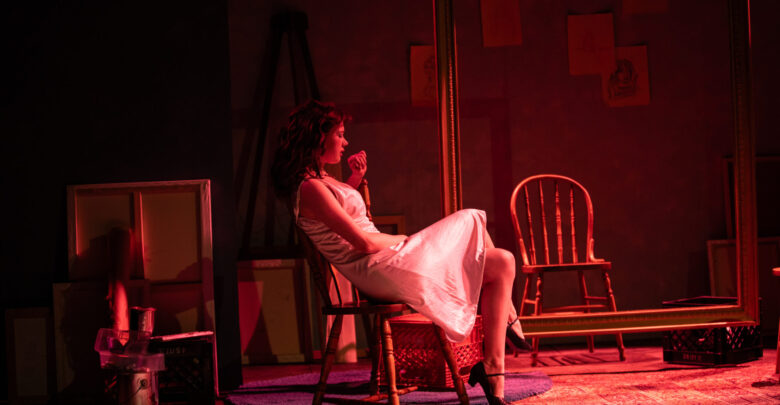Play Review: 2024 New Works Festival (Night B)
The second night of the New Works Festival featured 'Burning Down the House' and 'The Picture of Elias Graham'.
 Kaylin Schenk
Kaylin SchenkEvery year, the University of Alberta’s department of drama runs the New Works Festival. This student-run event is a great learning opportunity for student playwrights. They get to develop their plays with others across the department, and showcase their work to the community.
Burning Down the House
Is it still arson if there is no one left to witness it?
The play follows Sebastian (Dave Paragas), Morris (Baran Demir), and newcomer Cass (Sarah Dolman) in a barren, retro-futuristic dystopian world. Long-time friends, Sebastian and Morris spend their days waiting for a bus that never comes. Until one day, it does. Cass arrives from the city to the small-town, Costco — named after the sole superstore. Sebastian and Morris’s dynamic is shaken up when the new girl catches Sebastian’s eye.
While this leads to comedic moments as he attempts to impress Cass, the love-triangle narrative is soon abandoned. Instead, the play focuses on Sebastian’s unusual condition and deep-seated hatred of the town. Although the story could’ve been been more developed, the 80s retro music in the backdrop fit seamlessly into the production. Each song set the tone of the play, resonating with the old-fashioned set and costumes.
Through his many fainting spells, Sebastian is transported to an alternate reality where he converses with Demir. Demir is Fate in various forms. A primary focus for Sebastian’s character is a persistence in his search for a way out. As a result, he turns to Fate to uncover his future. While these interactions seem straight out of a fever dream, Sebastian’s unique relationship with Demir’s characters further blurs the lines between hallucinations and reality.
The existential play tries to keep many balls afloat throughout. It hints at a love triangle and incorporates dancing and light-hearted comedy. At the same time, it deals with the retro-futuristic aftermath of an apocalypse, mysterious medical conditions, and alternate dimensions. The musical choices complement the play effectively. But, juggling too much all at once runs the risk of not all of them landing right.
At its core, it’s a niche production that addresses the pitfalls of escapism, which blind Sebastian to everything he already has. However, its intended theme becomes convoluted with too many elements being added to the mix. The unexpected twists and turns make certain the audience won’t know what comes next, but can also serve as subtle reminders that sometimes less is more.
The Picture of Elias Graham
The Picture of Elias Graham shines a spotlight on the jarring reality of gender dysphoria and the complexity of navigating an identity crisis while being in a relationship. The entire play unfolds in Elias Graham’s (Auveen Amiri) boyfriend’s studio. Here, paintings come to life and relationships are pushed into unchartered territory.
In the opening scene, Felix (Trey Maruyama) puts the final touches on the Girl in the painting (Gabrielle Gades), an attempted recreation of his girlfriend Elias’s feminine beauty. Discomfort apparent, Elias grapples with the reality that something isn’t right, even though everything else seems to remain the same.
As Elias grapples with the literal personification of their internal conflict, Felix’s identity struggles become apparent. Felix has to now discover what that means for their relationship. In his efforts to do right by Elias, he puts the Girl through multiple outfit changes, getting it very wrong. Being stripped of her dress on stage, Gades’ transformation from femme to masc becomes one of the most powerful moments in the play.
Moments of gender dysphoria are characterized by sounds of static. While playing the same burst of audio is essential to stress Elias’ self-conflict in this case, relying on one tune for scene transitions risks audience fatigue. However, the intricate and conscious choices made throughout the play tie the narrative together beautifully. Small details become purposeful, exemplified by Elias’ statement, “I don’t need you anymore,” directed at the Girl while Felix remains also in their line of sight.
The play reaches its climax when the manifestation of internal struggle erupts into external conflict. Elias stabs the Girl but hurts themself. Amiri portrays Elias’ desperation with remarkable depth, illustrating their aggression as stemming from the desire to break free from the gender expectations forced upon them. At the same time, the Girl showcases a different side of her usually melodramatic character. She’s altered by self-preservation and willing to submit to Elias’ assertion of autonomy. Furthermore, the last scene juxtaposes red lighting with the blue paint staining the Girl’s arms. This highlights the shifting power dynamics with Elias now in control of their identity.
Felix and Elias’ relationship ends on a hopeful note that they might find their way back to each other. But, only after they’ve completed their respective journeys of self-discovery.
The Picture of Elias Graham shines a spotlight on the jarring reality of gender dysphoria and the complexity of navigating an identity crisis while being in a relationship. Throughout the play, Elias is trapped in constant conflict with the representation of who everyone thinks they should be. They finally break free by taking ownership of their life and shedding their past-self. This is the only way to welcome a future where he is free to become who he wants to be.




